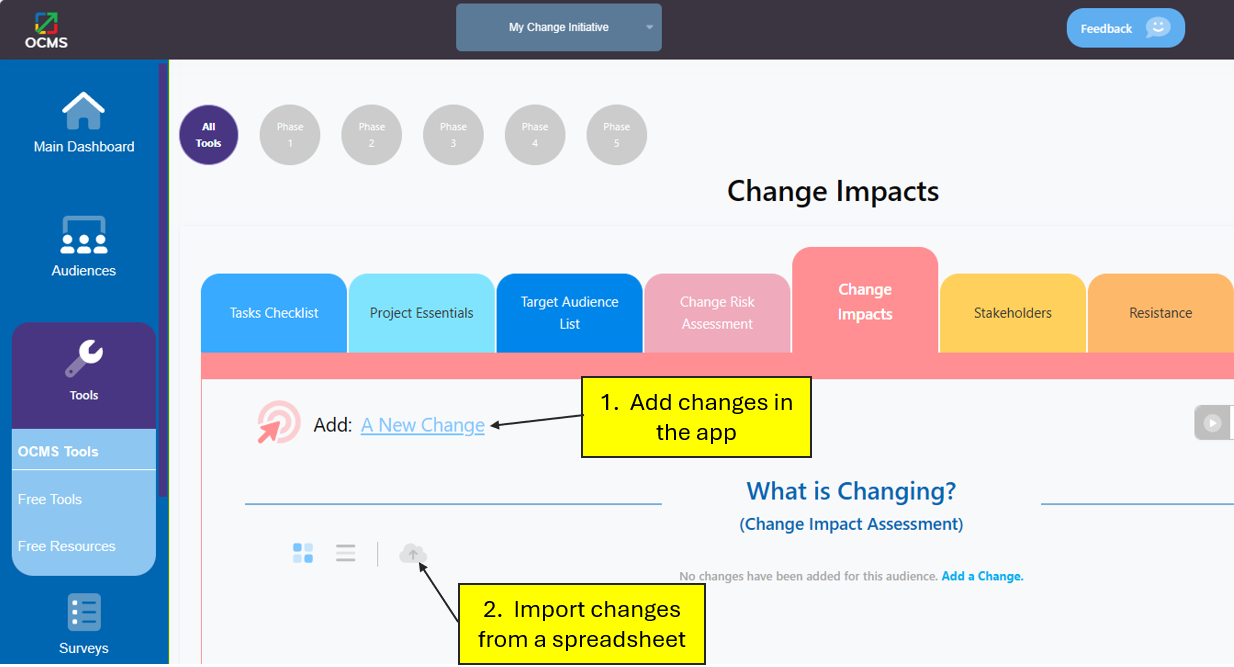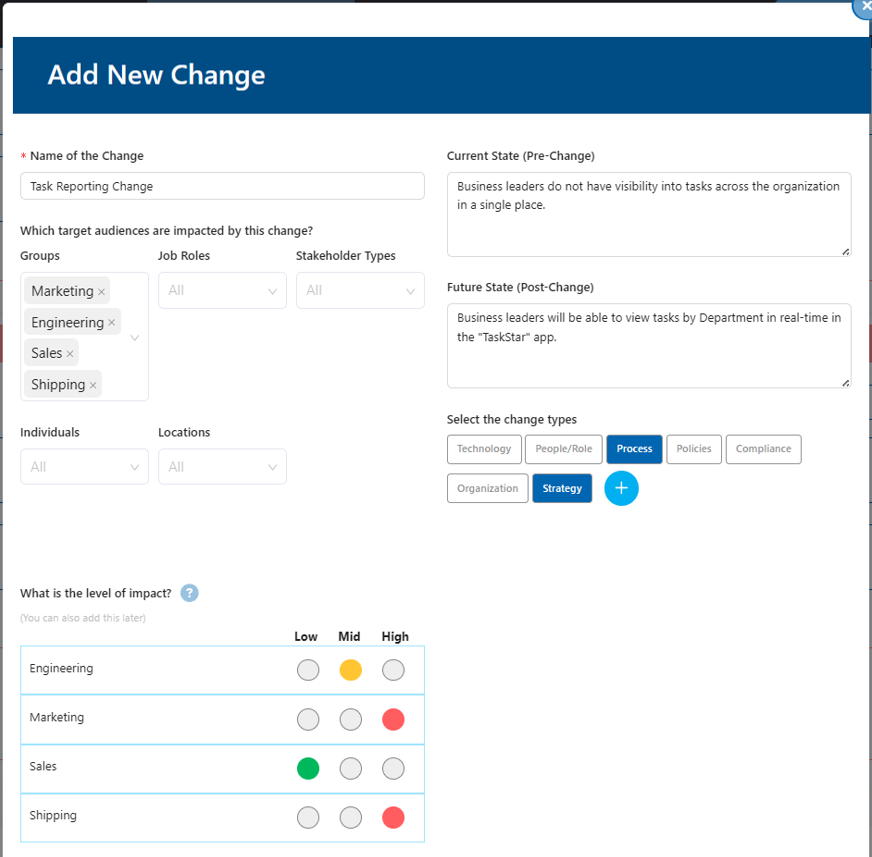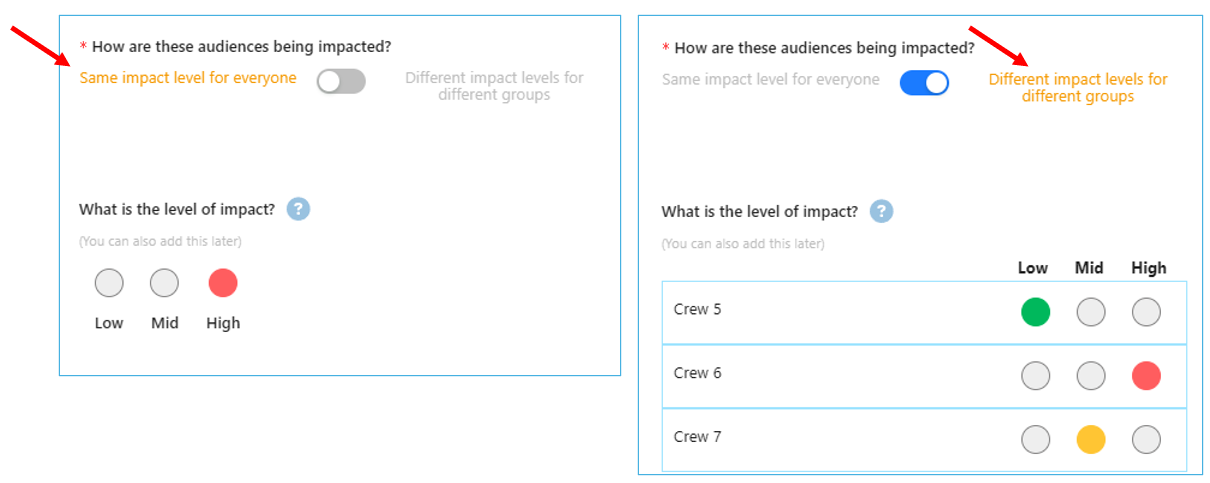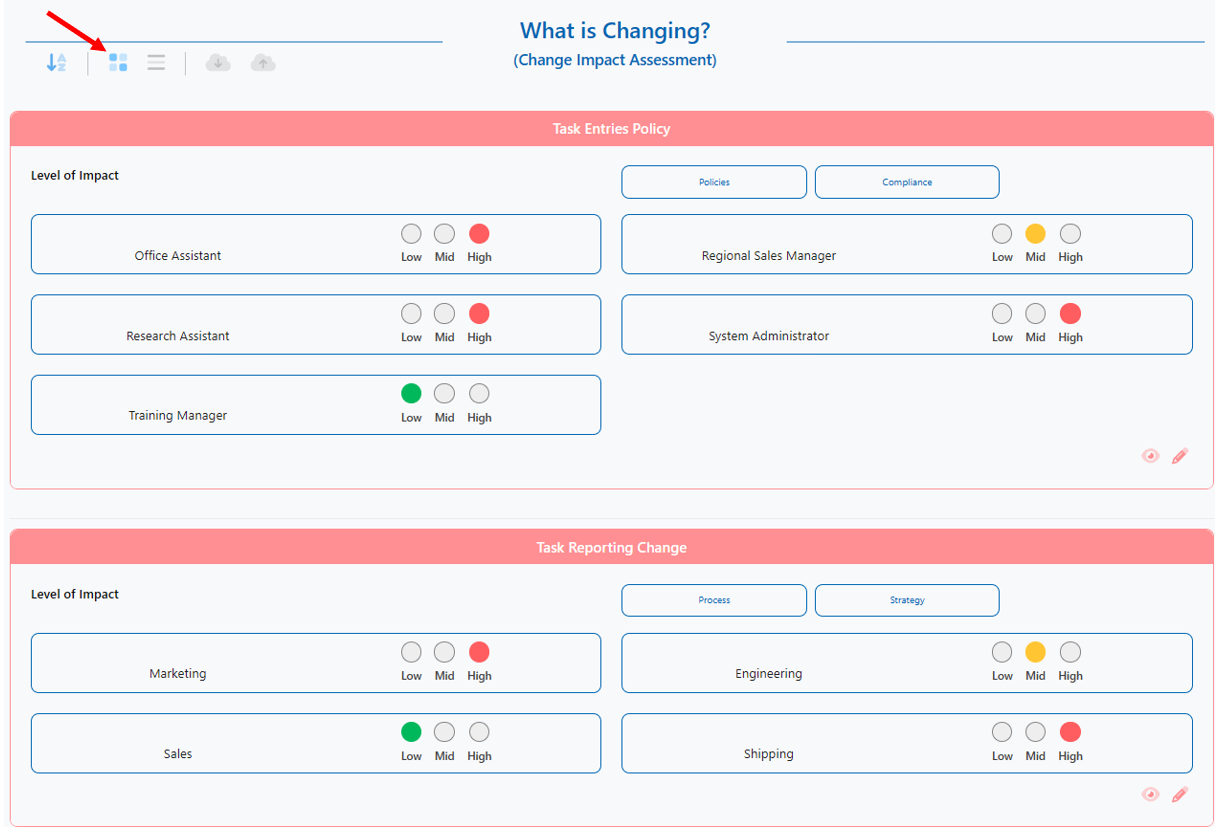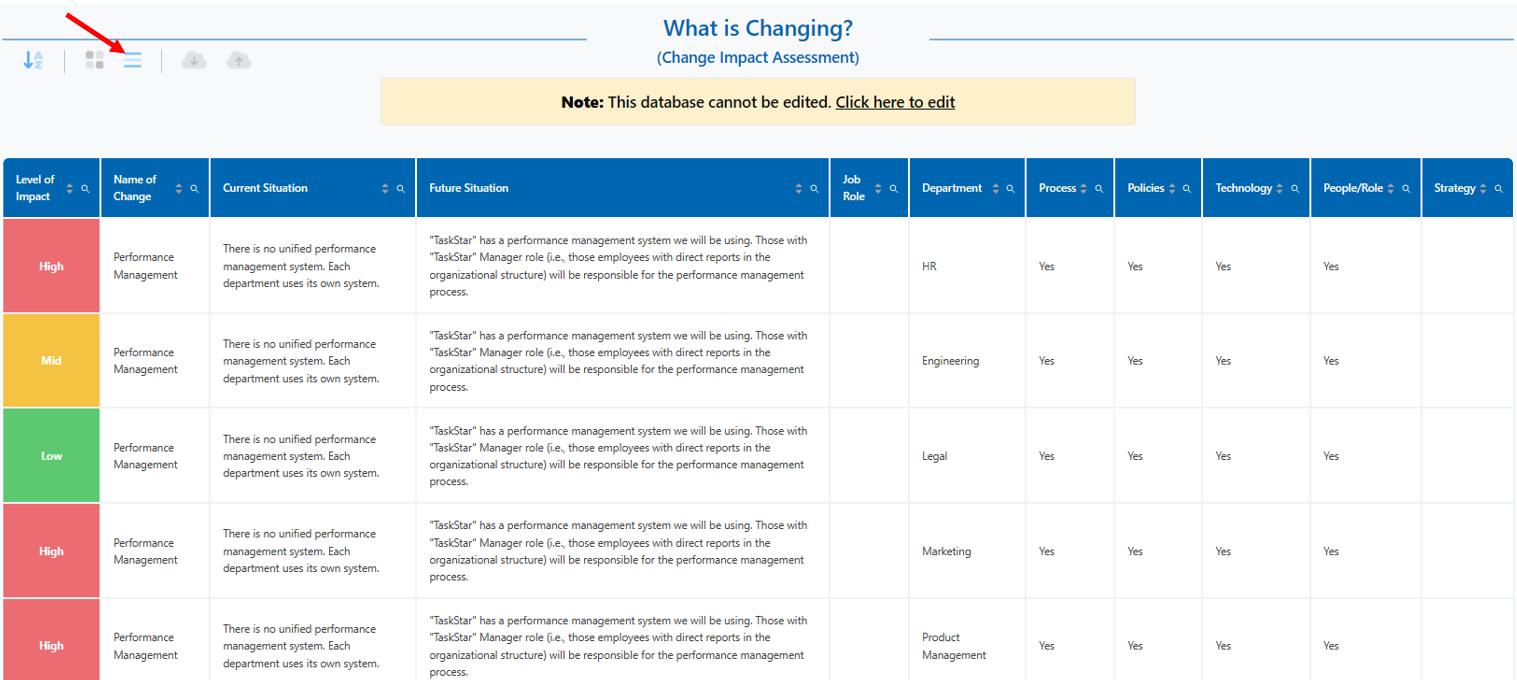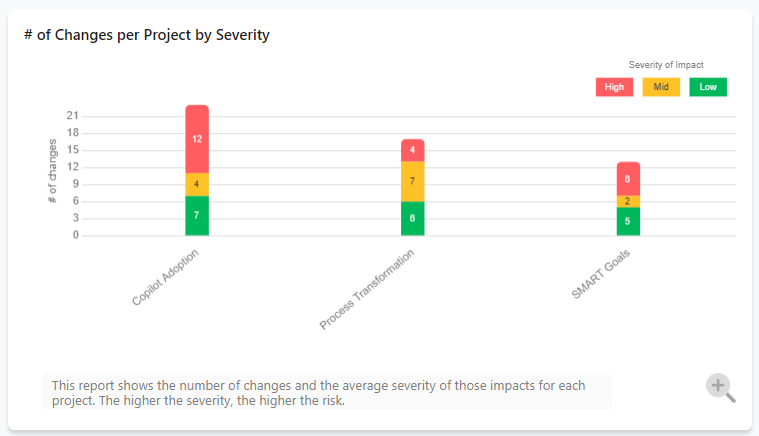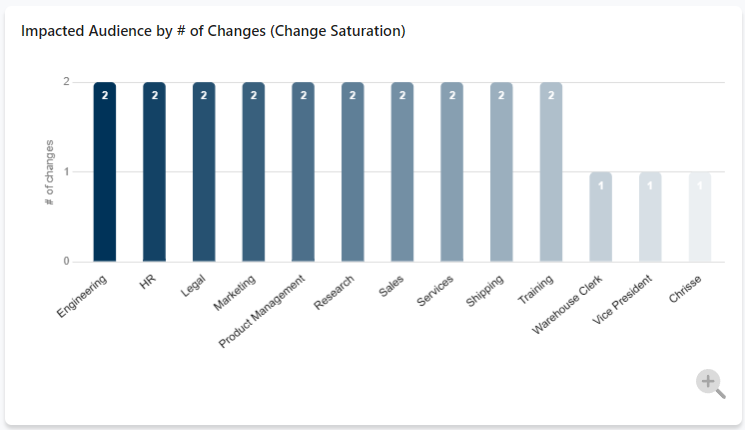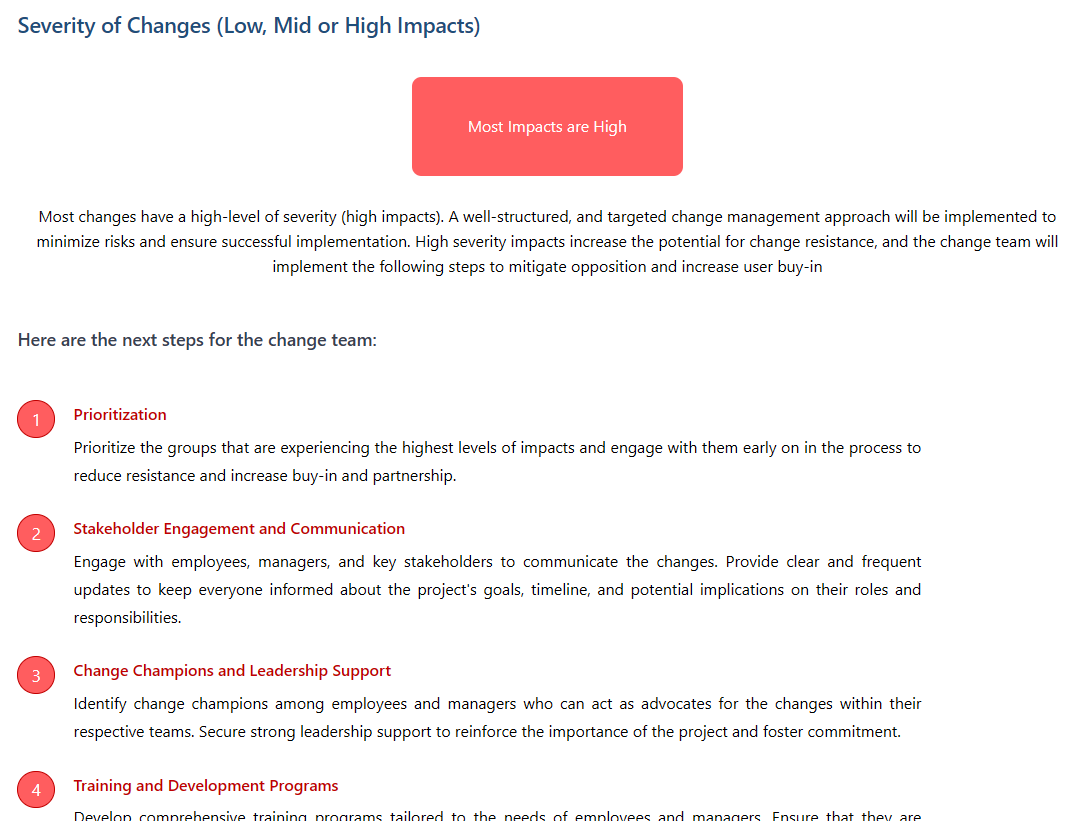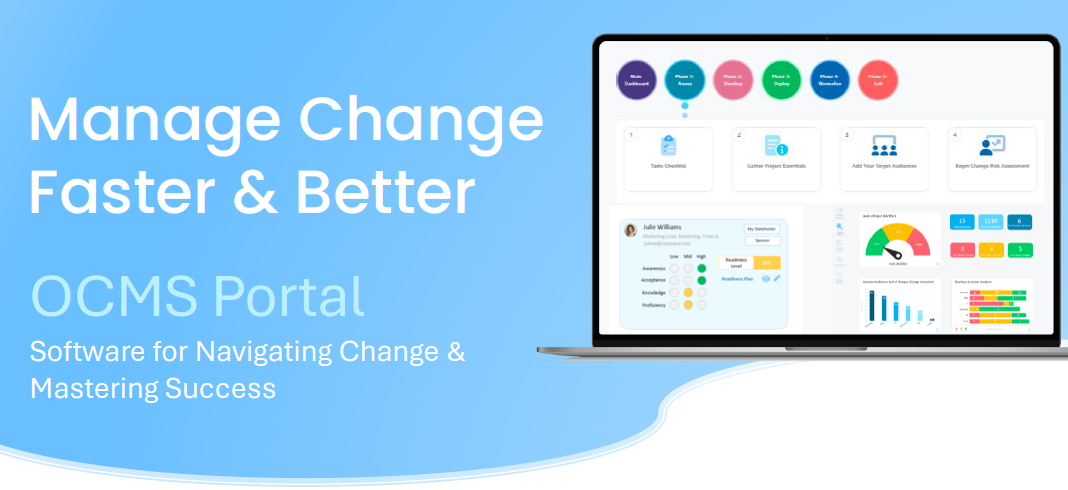How to Use OCMS Portal for Effective Change Impact Assessments
A change impact assessment (CIA) is one of the most important deliverables required of change management teams. Understanding the potential impact of change on various stakeholders and groups is crucial for a smooth and successful transition. But not all OCM teams know how to conduct a business impact analysis to get the outputs that executives need.
Using spreadsheets is cumbersome, and it makes it difficult to connect impacted groups with communication, training, and other necessary engagement activities.
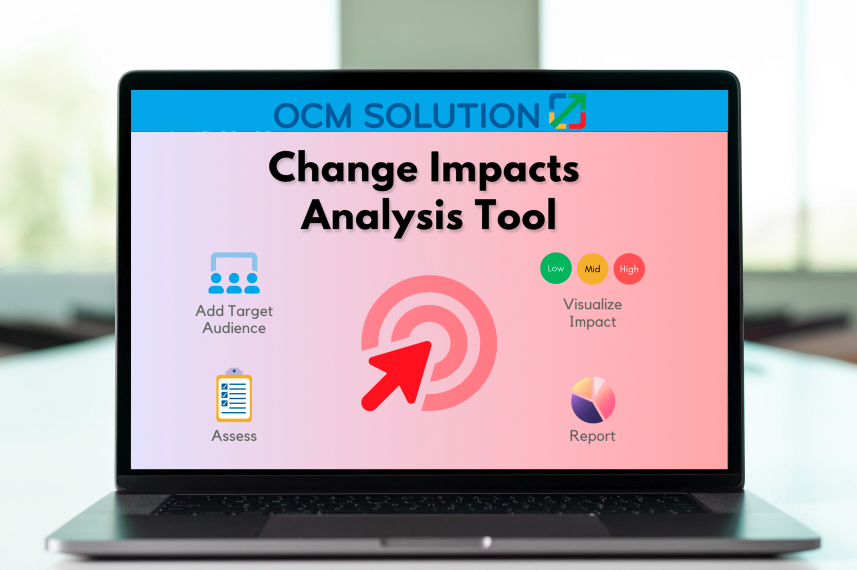
The OCMS Portal change management platform is designed to make change impact assessments easy and customizable. If you’ve been wondering how to do a change impact assessment successfully, read on.
We’ll explore how the OCMS Portal change management tool can streamline this process. By following this guide and utilizing the features of OCMS Portal, you can conduct thorough and insightful CIAs, effectively anticipating and mitigating potential disruptions caused by change.
Watch a tutorial below:
Why Conduct a Change Impact Assessment?
A change impact assessment, also known as a business impact analysis, is a systematic process of identifying and evaluating the potential effects of a proposed change on an organization. Here’s why it’s essential for change management to know how to do a business impact analysis:
- Understanding the Ripple Effect: Change rarely occurs in isolation. A change impact analysis helps you map out the ripple effect of a change, uncovering its impact on interconnected processes, workflows, and resources.
- Identifying Potential Risks: By proactively identifying potential risks associated with the change, a business impact analysis allows you to develop mitigation strategies and minimize disruptions.
- Prioritizing Change Initiatives: Change impact assessments help prioritize change initiatives based on their overall impact, allowing you to focus on those with the most significant benefits and least potential disruption.
- Resource Allocation: A comprehensive change impact analysis allows for more accurate resource allocation, ensuring the availability of people, equipment, and training required for a smooth transition.
- Stakeholder Management: Change impact assessments help identify stakeholders impacted by the change and facilitate communication and engagement strategies to ensure their support and buy-in.
By knowing how to conduct business impact analysis, you can navigate change with greater certainty and minimize potential roadblocks on the path to successful implementation.
Are you still wondering things like “How do you analyze the impact of a change?” or “How to do a change impact assessment?” Please reach out and let us know.
How OCMS Portal Can Streamline Your Change Impact Assessment
The OCMS Portal is a powerful change management tool that equips you with features to conduct comprehensive change impact assessments. Here are the steps for how to conduct a change impact assessment in the platform’s change impacts tool.
Prerequisite:
Before you can indicate change impacts for various groups, you need to have added your project’s Target Audience. For details on how to do that, watch this video tutorial.
1. Adding New Changes
OCMS Portal allows you to easily add the changes that are happening to the organization as a result of the project. First, you’ll need to determine the answer to, “How do you analyze the impact of a change?”
Here are some ways organizations analyze change impacts:
- By process: Each process that is changing is considered 1 “change”
- By workflow area: Each workflow area that is changing is considered 1 “change”
- By system/tool: Each system or tool changing is considered 1 “change”
- By policy: Each policy or rule change is considered 1 “change”
There is no single definition for how to perform business impact analysis. How you define your “changes” is largely determined by the project and the changes it is driving throughout the organization.
- Log into OCMS Portal and click “Tools > Change Impacts”
- Click to Add a Change OR click to download the template to import your changes from a spreadsheet.
c. Add the name of the change
The names of your changes and the total number of changes should reflect your assessment of the project and previous answer to “How do we analyze change impact in our organization?”
2. Identifying Target Audience
Within the OCMS Portal, you can specify the specific target audience impacted by the change. This could include departments, teams, or individual roles within the organization.
Choose ONE (1) method of choosing the audience impacted. For example, choose EITHER Department OR Job Role for each change.
If you’re wondering how to conduct a business impact analysis where you can look at a mix of impacted groups, the way to do this is to create a separate change for each type. For example, one change may impact departments, while another change may impact job roles.
3. Mapping Current and Future States
Describe the organization’s current state (before the change) and the desired future state (after the change) for each change you add.
4. Defining the Type of Change
The platform provides a flexible system for defining the type of change being implemented. Whether it’s a process change, technological shift, or restructuring initiative, you can choose the most relevant category or even create your own custom category.
On the Portfolio Overview Reports dashboard, you’ll be able to filter by Type of Change, giving you insightful ways to look at change impacts across all projects.
5. Assessing Impact Levels
One of the key parts of how to do a change impact assessment is assessing the level/severity of impact for the identified groups. OCMS Portal offers an impact assessment framework that allows you to rate the potential impact of the change on the target audience using “High, Mid, Low.”
If all impacted groups have the same level of impact, simply leave the slider at the default and choose the impact level. If groups have different impact levels, move the slider to “Different impact levels for different groups” and choose the level for each group.
Need help understanding how to do a business impact analysis estimate for the level of impact? Just click the tooltip next to “What is the level of impact?” for tips.
Finally, click “Save” to save the change.
6. Viewing Your Data (Grid & List Views)
OCMS Portal’s Change Impact Assessment Tool provides two views to visualize your data.
Grid View: See a user-friendly view in Grid View. You can also quickly change the level of impact here without needing to reopen the change window.
List View: See a list (spreadsheet) view that displays your changes, including the current and future states for each change.
7. Change Impact Analytics Reports
OCMS Portal further provides actionable analytics to visualize the overall impact of the change across various areas and stakeholders. You can find reporting driven by your change impacts assessment in the following places.
Portfolio Overview Reports: See a breakdown of impacts for groups across all projects.
Change Metrics Reports: Drill down into the change impacts for one particular project.
OCM Plan: The autogenerated OCM plan also includes detailed recommendations based on your business change impact assessment.
These features make OCMS Portal a valuable tool for conducting efficient and insightful change impact assessments, providing a centralized location for data.
Do you still have questions about how to perform business impact analysis? Please reach out and let us know.
Beyond the Tool: How to Conduct a Change Impact Assessment Best Practices
While OCMS Portal offers powerful features, it’s important to combine the tool with best practices in how to conduct business impact analysis:
- Clearly Define Change Scope: Clearly outline the scope of the proposed change to ensure everyone involved understands its boundaries and potential impact zones.
- Engage Stakeholders: Actively involve key stakeholders in the business impact analysis process (e.g., supervisors or managers). Their insights and concerns can provide valuable perspectives on the change’s impact.
- Utilize a Scalable Approach: Tailor the depth of your change impact assessment to the complexity of the change. Simple changes may require less detailed analysis, while major organizational transformations may warrant extensive assessment.
- Communicate Effectively: Clearly communicate the findings of the change impact analysis to all stakeholders, outlining the anticipated impact and any planned mitigation efforts. Transparency fosters trust and helps manage expectations.
- Monitor and Adapt: The impact of change can be dynamic. Monitor the actual impact of the change after implementation and adjust your strategies or assessment as needed.
By following these best practices in conjunction with the functionalities of OCMS Portal, you can conduct thorough and insightful change impact assessments, setting the stage for a smooth and successful change implementation process.
Still looking for more insights on “How do we analyze change impact?” Please reach out and let us know.
Conclusion: OCMS Portal Helps You Manage Change with Confidence
Change, while often necessary, can be disruptive. But by conducting comprehensive change impact assessments, you can navigate transitions with greater confidence. The OCMS Portal simplifies the business impact analysis process, providing a centralized platform to identify potential impacts, develop mitigation strategies, and manage stakeholder engagement. Our comprehensive tools help you move confidently towards more successful change initiatives.
Subscribe to OCMS Portal Today!
Handle your entire change management process – from change impact analysis to adoption assessment with a single platform! OCMS Portal has the power and flexibility to help you manage change more successfully.
Sign up for a Free Trial OR Subscribe Now
FAQ: How to Conduct a Business Impact Analysis
How do you analyze the impact of a change?
Here are some tips on assessing the impact level of a change.:
High: Requires significant attention, time, or action by audience. The effect is highly disruptive to the current state.
Medium: Requires focused attention. Impacted audiences will notice this change and failure to address it will result in a loss of adoption or reduced performance.
Low: Does not require significant attention. Impacted audiences may notice, but would likely adapt on their own. A failure to adopt would not result in reduced performance.
What is a change impact assessment?
A change impact assessment, also known as a business impact analysis, is a systematic process of identifying and evaluating the potential effects of a proposed change on an organization.
Why conduct a change impact assessment?
Here's why it’s essential for change management to know how to do a business impact analysis: Understanding the Ripple Effect, Identifying Potential Risks, Prioritizing Change Initiatives, Resource Allocation, and Stakeholder Management.
Note: Content on OCM Solution's ocmsolution.com website is protected by copyright. Should you have any questions or comments regarding this OCM Solutions page, please reach out to Ogbe Airiodion (Change Management Lead) or the OCM Solutions Team today.
External Sources: stock.adobe.com


